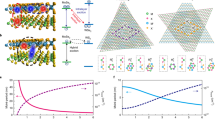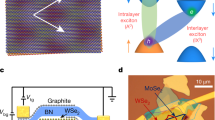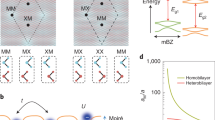Abstract
Moiré patterns of transition metal dichalcogenide heterobilayers have proved to be an ideal platform on which to host unusual correlated electronic phases, emerging magnetism and correlated exciton physics. Whereas the existence of new moiré excitonic states is established1,2,3,4 through optical measurements, the microscopic nature of these states is still poorly understood, often relying on empirically fit models. Here, combining large-scale first-principles GW (where G and W denote the one-particle Green's function and the screened Coulomb interaction, respectively) plus Bethe–Salpeter calculations and micro-reflection spectroscopy, we identify the nature of the exciton resonances in WSe2/WS2 moiré superlattices, discovering a rich set of moiré excitons that cannot be captured by prevailing continuum models. Our calculations show moiré excitons with distinct characters, including modulated Wannier excitons and previously unidentified intralayer charge-transfer excitons. Signatures of these distinct excitonic characters are confirmed experimentally by the unique carrier-density and magnetic-field dependences of different moiré exciton resonances. Our study highlights the highly non-trivial exciton states that can emerge in transition metal dichalcogenide moiré superlattices, and suggests new ways of tuning many-body physics in moiré systems by engineering excited-states with specific spatial characters.
This is a preview of subscription content, access via your institution
Access options
Access Nature and 54 other Nature Portfolio journals
Get Nature+, our best-value online-access subscription
$29.99 / 30 days
cancel any time
Subscribe to this journal
Receive 51 print issues and online access
$199.00 per year
only $3.90 per issue
Buy this article
- Purchase on Springer Link
- Instant access to full article PDF
Prices may be subject to local taxes which are calculated during checkout




Similar content being viewed by others
Data availability
All data are available in the main text, Methods or Supplementary Information. The DFT and GW-BSE calculations presented in the paper were carried out using publicly available electronic structure codes (referenced in the Methods section). Our findings can be fully reproduced by the use of these codes and following the procedure outlined in the paper.
References
Jin, C. et al. Observation of moiré excitons in WSe2/WS2 heterostructure superlattices. Nature 567, 76–80 (2019).
Tran, K. et al. Evidence for moiré excitons in van der Waals heterostructures. Nature 567, 71–75 (2019).
Seyler, K. L. et al. Signatures of moiré-trapped valley excitons in MoSe2/WSe2 heterobilayers. Nature 567, 66–70 (2019).
Alexeev, E. M. et al. Resonantly hybridized excitons in moiré superlattices in van der Waals heterostructures. Nature 567, 81–86 (2019).
Cao, Y. et al. Unconventional superconductivity in magic-angle graphene superlattices. Nature 556, 43–50 (2018).
Cao, Y. et al. Correlated insulator behaviour at half-filling in magic-angle graphene superlattices. Nature 556, 80–84 (2018).
Regan, E. C. et al. Mott and generalized Wigner crystal states in WSe2/WS2 moiré superlattices. Nature 579, 359–363 (2020).
Xian, L., Kennes, D. M., Tancogne-Dejean, N., Altarelli, M. & Rubio, A. Multiflat bands and strong correlations in twisted bilayer boron nitride: doping-induced correlated insulator and superconductor. Nano Lett. 19, 4934–4940 (2019).
Wang, L. et al. Correlated electronic phases in twisted bilayer transition metal dichalcogenides. Nat. Mater. 19, 861–866 (2020).
Tang, Y. et al. Simulation of Hubbard model physics in WSe2/WS2 moiré superlattices. Nature 579, 353–358 (2020).
Andersen, T. I. et al. Excitons in a reconstructed moiré potential in twisted WSe2/WSe2 homobilayers. Nat. Mater. 20, 480–487 (2021).
Karni, O. et al. Structure of the moiré exciton captured by imaging its electron and hole. Nature 603, 247–252 (2022).
Zhang, L. et al. Van der Waals heterostructure polaritons with moiré-induced nonlinearity. Nature 591, 61–65 (2021).
Xu, Y. et al. Correlated insulating states at fractional fillings of moiré superlattices. Nature 587, 214–218 (2020).
Wu, F., Lovorn, T. & MacDonald, A. H. Topological exciton bands in moiré heterojunctions. Phys. Rev. Lett. 118, 147401 (2017).
Brem, S., Linderälv, C., Erhart, P. & Malic, E. Tunable phases of moiré excitons in van der Waals heterostructures. Nano Lett. 20, 8534–8540 (2020).
Naik, M. H. & Jain, M. Ultraflatbands and shear solitons in moiré patterns of twisted bilayer transition metal dichalcogenides. Phys. Rev. Lett. 121, 266401 (2018).
Li, H. et al. Imaging moiré flat bands in three-dimensional reconstructed WSe2/WS2 superlattices. Nat. Mater. 20, 945–950 (2021).
Naik, M. H., Kundu, S., Maity, I. & Jain, M. Origin and evolution of ultraflat bands in twisted bilayer transition metal dichalcogenides: realization of triangular quantum dots. Phys. Rev. B. 102, 075413 (2020).
Zhang, Z. et al. Flat bands in twisted bilayer transition metal dichalcogenides. Nat. Phys. 16, 1093–1096 (2020).
Weston, A. et al. Atomic reconstruction in twisted bilayers of transition metal dichalcogenides. Nat. Nanotechnol. 15, 592–597 (2020).
Angeli, M. & MacDonald, A. H. Γ valley transition metal dichalcogenide moiré bands. Proc. Natl Acad. Sci. USA 118, e2021826118 (2021).
Rohlfing, M. & Louie, S. G. Electron–hole excitations and optical spectra from first principles. Phys. Rev. B. 62, 4927–4944 (2000).
Hybertsen, M. S. & Louie, S. G. Electron correlation in semiconductors and insulators: band gaps and quasiparticle energies. Phys. Rev. B. 34, 5390–5413 (1986).
Qiu, D. Y., da Jornada, F. H. & Louie, S. G. Optical spectrum of MoS2: Many-body effects and diversity of exciton states. Phys. Rev. Lett. 111, 216805 (2013).
Guo, H., Zhang, X. & Lu, G. Shedding light on moiré excitons: a first-principles perspective. Sci. Adv. 6, eabc5638 (2020).
Naik, M. H., Maity, I., Maiti, P. K. & Jain, M. Kolmogorov–Crespi potential for multilayer transition-metal dichalcogenides: capturing structural transformations in moiré superlattices. J. Phys. Chem. C. 123, 9770–9778 (2019).
Li, H. et al. Imaging local discharge cascades for correlated electrons in WS2/WSe2 moiré superlattices. Nat. Phys. https://doi.org/10.1038/s41567-021-01324-x (2021).
Jin, C. et al. Imaging of pure spin-valley diffusion current in WS2-WSe2 heterostructures. Science 360, 893–896 (2018).
Liang, Y. & Yang, L. Carrier plasmon induced nonlinear band gap renormalization in two-dimensional semiconductors. Phys. Rev. Lett. 114, 063001 (2015).
Liu, E. et al. Excitonic and valley-polarization signatures of fractional correlated electronic phases in a WSe2/WS2 moiré superlattice. Phys. Rev. Lett. 127, 037402 (2021).
Efimkin, D. K., Laird, E. K., Levinsen, J., Parish, M. M. & MacDonald, A. H. Electron-exciton interactions in the exciton-polaron problem. Phys. Rev. B. 103, 075417 (2021).
Liu, E. et al. Exciton-polaron Rydberg states in monolayer MoSe2 and WSe2. Nat. Commun. 12, 6131 (2021).
Mak, K. F., He, K., Shan, J. & Heinz, T. F. Control of valley polarization in monolayer MoS2 by optical helicity. Nature Nanotech. 7, 494–498 (2012).
Cao, T. et al. Valley-selective circular dichroism of monolayer molybdenum disulphide. Nat. Commun. 3, 887 (2012).
Zeng, H., Dai, J., Yao, W., Xiao, D. & Cui, X. Valley polarization in MoS2 monolayers by optical pumping. Nature Nanotech. 7, 490–493 (2012).
Li, J. et al. Spontaneous valley polarization of interacting carriers in a monolayer semiconductor. Phys. Rev. Lett. 125, 147602 (2020).
Wang, Z., Mak, K. F. & Shan, J. Strongly interaction-enhanced valley magnetic response in monolayer WSe2. Phys. Rev. Lett. 120, 066402 (2018).
Braun, C. L. Electric field assisted dissociation of charge transfer states as a mechanism of photocarrier production. J. Chem. Phys. 80, 4157–4161 (1984).
Hinrichsen, T. F. et al. Long-lived and disorder-free charge transfer states enable endothermic charge separation in efficient non-fullerene organic solar cells. Nat. Commun. 11, 5617 (2020).
Plimpton, S. Computational limits of classical molecular dynamics simulations. Comput. Mater. Sci. 4, 361–364 (1995).
Naik, S., Naik, M. H., Maity, I. & Jain, M. Twister: construction and structural relaxation of commensurate moiré superlattices. Comp. Phys. Commun. https://doi.org/10.1016/j.cpc.2021.108184 (2021).
Giannozzi, P. et al. QUANTUM ESPRESSO: a modular and open-source software project for quantum simulations of materials. J. Phys. Condens. Matter 21, 395502 (2009).
Deslippe, J. et al. BerkeleyGW: a massively parallel computer package for the calculation of the quasiparticle and optical properties of materials and nanostructures. Comput. Phys. Commun. 183, 1269–1289 (2012).
Carr, S. et al. Relaxation and domain formation in incommensurate two-dimensional heterostructures. Phys. Rev. B. 98, 224102 (2018).
Soler, J. M. et al. The SIESTA method for ab initio order-N materials simulation. J. Phys. Condens. Matter 14, 2745–2779 (2002).
Troullier, N. & Martins, J. L. Efficient pseudopotentials for plane-wave calculations. Phys. Rev. B. 43, 1993–2006 (1991).
Bradley, A. J. et al. Probing the role of interlayer coupling and Coulomb interactions on electronic structure in few-layer MoSe2 nanostructures. Nano Lett. 15, 2594–2599 (2015).
Naik, M. H. & Jain, M. Origin of layer dependence in band structures of two-dimensional materials. Phys. Rev. B 95, 165125 (2017).
Kundu, S., Naik, M. H., Krishnamurthy, H. R. & Jain, M. Moiré induced topology and flat bands in twisted bilayer WSe2: A first-principles study. Phys. Rev. B 105, L081108 (2022).
Ku, W., Berlijn, T. & Lee, C.-C. Unfolding first-principles band structures. Phys. Rev. Lett. 104, 216401 (2010).
Matsushita, Y., Nishi, H., Iwata, J., Kosugi, T. & Oshiyama, A. Unfolding energy spectra of double-periodicity two-dimensional systems: twisted bilayer graphene and MoS2 on graphene. Phys. Rev. Materials 2, 010801 (2018).
Giustino, F., Yates, J. R., Souza, I., Cohen, M. L. & Louie, S. G. Electron-phonon interaction via electronic and lattice Wannier functions: superconductivity in boron-doped diamond reexamined. Phys. Rev. Lett. 98, 047005 (2007).
Kumar, N. et al. Second harmonic microscopy of monolayer MoS2. Phys. Rev. B 87, 161403 (2013).
Li, Y. et al. Probing symmetry properties of few-layer MoS2 and h-BN by optical second-harmonic generation. Nano Lett. 13, 3329–3333 (2013).
Wang, L. et al. One-dimensional electrical contact to a two-dimensional material. Science 342, 614–617 (2013).
Acknowledgements
This work was primarily supported by the Director, Office of Science, Office of Basic Energy Sciences, Materials Sciences and Engineering Division of the US Department of Energy under the van der Waals heterostructure program (KCWF16), contract number DE-AC02-05CH11231, which provided the theoretical PUMP formulation and experimental measurements, supported by the Center for Computational Study of Excited-State Phenomena in Energy Materials (C2SEPEM) at Lawrence Berkeley National Laboratory, supported by the US Department of Energy, Office of Science, Basic Energy Sciences, Materials Sciences and Engineering Division under contract no. DE-AC02-05CH11231, as part of the Computational Materials Sciences Program that provided advanced codes and simulations, and supported by the Theory of Materials Program (KC2301) financed by the US Department of Energy, Office of Science, Basic Energy Sciences, Materials Sciences and Engineering Division under contract no. DE-AC02-05CH11231 that provided conceptual and symmetry analyses of excitons. Computational resources were provided by National Energy Research Scientific Computing Center, which is supported by the Office of Science of the US Department of Energy under contract no. DE-AC02-05CH11231, Stampede2 at the Texas Advanced Computing Center (TACC), The University of Texas at Austin through Extreme Science and Engineering Discovery Environment (XSEDE), which is supported by National Science Foundation under grant no. ACI-1053575 and Frontera at TACC, which is supported by the National Science Foundation under grant no. OAC-1818253.
Author information
Authors and Affiliations
Contributions
S.G.L. conceived the project. M.H.N., Y.H.C., Z.L., C.S.O., F.H.J. and S.G.L. developed the theory and performed the GW-BSE calculations. E.C.R., Z.Z., D.W., Y.Y. and F.W. carried out optical measurements and analysis. E.C.R., Z.Z., D.W., W.Z., S.Z., M.I.B.U., B.G. and X.W. fabricated van der Waals heterostructures. M.S., K.Y. and S.T. grew WSe2 and WS2 crystals. K.W. and T.T. grew hexagonal boron nitride crystals.
Corresponding author
Ethics declarations
Competing interests
The authors declare no competing interests.
Peer review
Peer review information
Nature thanks the anonymous reviewers for their contribution to the peer review of this work.
Additional information
Publisher’s note Springer Nature remains neutral with regard to jurisdictional claims in published maps and institutional affiliations.
Extended data figures and tables
Extended Data Fig. 1 Electronic structure of reconstructed and rigidly aligned WSe2/WS2 heterostructure.
(a) Type II band alignment of the K valley band states in the WSe2/WS2 heterostructure. The valence band-edge states in the bilayer correspond to the WSe2 states, while the conduction band-edge states correspond to WS2. (b and c) Comparison of electronic band structure of the reconstructed and rigidly aligned bilayers. The reconstructed superlattice has flatter bands and larger gap openings at the Brillouin zone edges. The band structure of the rigidly aligned bilayer, on the other hand, is virtually identical to the folded band structure of the pristine monolayer WSe2 (orange-dashed line) at the valence band edge. Furthermore, the electronic band structure of the reconstructed monolayer WSe2 is very similar to the bilayer valence states (green-dashed line).
Extended Data Fig. 2 Influence of out-of-plane displacements to the electronic structure.
(a) Schematic of transformation (the vertical displacement is grossly exaggerated by a factor of 100 for illustration) of the reconstructed WSe2 layer to remove out-of-plane displacements while retaining the in-plane reconstruction. The position of atoms is kept intact in the in-plane direction while vertical displacements from the monolayer configuration are set to zero. (b) Comparison of the electronic band structure of the reconstructed WSe2 with and without out-of-plane displacements.
Extended Data Fig. 3 Pristine unit-cell expansion of moiré wavefunctions.
(a) Two representative Bloch state of the pristine WSe2 crystal in real space, arbitrarily displaced along the vertical axis for illustration. The wavefunction is averaged along the out-of-plane direction and the real part is plotted along the (110) direction in the pristine superlattice. (b) Real part of the strained-superlattice wavefunction (black solid line) corresponding to the valence band maximum at the γ point. This is compared to the wavefunction constructed (orange dashed line) as a linear superposition of the pristine basis states. x = 0 here corresponds to the AA stacking in the superlattice. (c) Similar plot as (b) comparing the conduction band minimum at the γ point. (d) Projection (sum of the square of the overlaps) of the strained superlattice valence and conduction wavefunctions, at the γ point in the moiré BZ, onto a basis of 24 pristine valence and 24 pristine conduction states, respectively. (e) The mapping of states involved in a kernel matrix element (described in the text) from the supercell BZ (black hexagon) to the unit-cell BZ (green hexagon).
Extended Data Fig. 4 Decomposition of exciton amplitude into valence and conduction band contributions.
Contribution of the moiré valence and conduction band states, with similar ordering as Fig. 1d, to the exciton corresponding to the three strong moiré exciton resonances.
Extended Data Fig. 5 Value of interband optical transition matrix elements from a valence band (marked in red) to all the conduction bands.
The transparency of the red dots in the conduction band indicates the relative strength of the matrix elements, with the darker color representing larger matrix element. For the pristine WSe2 layer (a), with bands folded to the corresponding moiré BZ, only matrix elements of transitions that correspond to momentum-direct transitions in the unit-cell Brillouin zone are nonzero. The inhomogeneous distribution of strains in the strained WSe2 superlattice (a real moiré crystal) changes the character of the wavefunctions of states at the moiré valence and moiré conduction bands leading to a qualitative change in the transition matrix elements (b).
Extended Data Fig. 6 Device information.
Sample schematics (upper panel), false-color optical microscope images (middle panel), and polarization-resolved SHG data (bottom panel) for three devices included in this study. In SHG data, the red (blue) circles correspond to normalized integrated SHG at different polarization angles θ for the WSe2 (WS2) layers, and the solid lines are corresponding fits to a cos2(3θ) function. (a) Device 1: Near-zero-degree, dual-gated WSe2/WS2 heterostructure described in main text. WSe2 monolayer region also described in main text. (b) Device 2: Misaligned WSe2/WS2 heterostructure (6 degrees) described in main text. (c) Device 3: Additional near-zero-degree, dual-gated WSe2/WS2 heterostructure described in S13.
Extended Data Fig. 7 Fitting of peak energies in doping dependent reflection contrast.
At each charge concentration, the spectrum was fit using three Lorentzian functions. The extracted peak energies are plotted only in doping ranges where the peaks can be easily distinguished. As discussed in the main text, peak I is not strongly modified by hole doping, while peak III redshifts with hole doping (scenario B) and blueshifts with electron doping (scenario B). We do not fit peak I under electron doping since it is mixed with peak III (scenario A).
Extended Data Fig. 8 Doping dependent reflection contrast spectra of moiré excitons in a second aligned WSe2/WS2 heterostructure, device 3.
The three moiré exciton states (I, II, III) show very similar doping dependence as the states shown in the main text (device 1).
Supplementary information
Supplementary Information
Supplementary text, figures and references.
Rights and permissions
About this article
Cite this article
Naik, M.H., Regan, E.C., Zhang, Z. et al. Intralayer charge-transfer moiré excitons in van der Waals superlattices. Nature 609, 52–57 (2022). https://doi.org/10.1038/s41586-022-04991-9
Received:
Accepted:
Published:
Issue Date:
DOI: https://doi.org/10.1038/s41586-022-04991-9
This article is cited by
-
Dynamically tunable moiré exciton Rydberg states in a monolayer semiconductor on twisted bilayer graphene
Nature Materials (2024)
-
Engineering interlayer hybridization in van der Waals bilayers
Nature Reviews Materials (2024)
-
Imaging moiré excited states with photocurrent tunnelling microscopy
Nature Materials (2024)
-
Ultrafast atomic-scale scanning tunnelling spectroscopy of a single vacancy in a monolayer crystal
Nature Photonics (2024)
-
The interplay of field-tunable strongly correlated states in a multi-orbital moiré system
Nature Physics (2024)
Comments
By submitting a comment you agree to abide by our Terms and Community Guidelines. If you find something abusive or that does not comply with our terms or guidelines please flag it as inappropriate.



